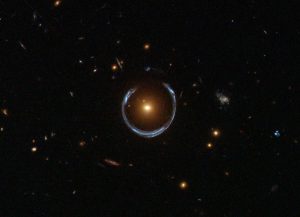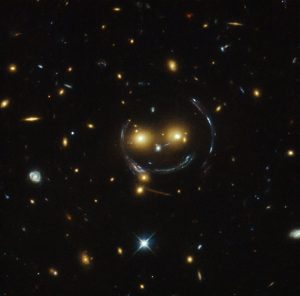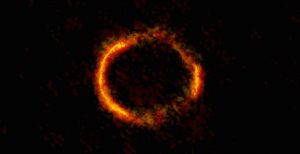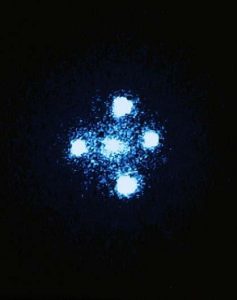Strong lensing
Strong lensing is visually, the most stunning form of gravitational lensing. Above iamge shows strong lensing effects in Abell 1689 cluster captured by hubble space telescope. The lensing effect is strong enough to be seen by the human eye on an astronomical image, we call it a strong lensing. So, it is easy to see and measure the effects of lensing. As its name suggests, it requires an extremely massive object as the lens. And for a strong lensing, it is required a good deal of alignment between the lens and the source. Galaxy clusters are the most common cause of strong gravitational lensing. In some special cases, the alignment of the source and the lens will be such that, light will be deflected to the observer forming an illusion called an “Einstein ring”. Hundreds of gravitational lenses are currently known. About half a dozen of them are partial Einstein rings with diameters up to an arc second, although as either the mass distribution of the lenses is not perfectly axially symmetrical, or the source, lens, and observer are not perfectly aligned, we have yet to see a perfect Einstein ring. Most rings have been discovered in the radio range. The degree of completeness needed for an image seen through a gravitational lens to qualify as an Einstein ring is yet to be defined. Most often than a ring, the source may get stretched out and curved, and form a tangential or radial arc.
A lot of mass is needed to cause an arc to appear, so that properties of arcs (number, size, geometry) can often be used to study massive objects like galaxy clusters. However, there are not that many clusters in the sky that cause such a large lensing effect. So these instances are very useful and pretty, but rare to observe.
Some of the interesting illusions caused by the strong gravitational lensing have been introduced here. They are namely, Einstein ring, partial arcs, multiple images and Einstein cross.
Einstein rings
A horseshoe Einstein ring from Hubble
In observational astronomy, Einstein ring also known as Einstein-Chwolson ring, is the deformation of light from a source into a ring through gravitational lensing of the source’s light by an object with an extremely large mass. Foreground galaxy acts like a lens and makes the distant source of light appear distorted but magnified, forming characteristic rings of light, known as Einstein rings. This phenomenon occurs when the source, the massive object and the observer are all aligned in a straight line. The original light will appear as a ring around the massive object.
The Einstein ring radius depends on the mass of the lensing object. The more massive the lens is, the larger the Einstein ring radius. It also depends on the distance between the observer, the lensing object and the background source. Gravitational lensing is most effective, which means the ring radius is largest, when the lensing object is half way between us and the background source.
“Smiley” or “Cheshire Cat” image of galaxy cluster (SDSS J1038+4849) and gravitational lensing (an “Einstein ring”) discovered by an international team of scientists, imaged with Hubble Space Telescope. In the centre of this image, taken with the NASA/ESA Hubble Space Telescope, are two faint galaxies that seem to be smiling. You can make out two orange eyes and a white button nose. In the case of this “happy face”, the two eyes are the galaxies SDSSCGB 8842.3 and SDSSCGB 8842.4 and the misleading smile lines are actually arcs caused by an effect known as strong gravitational lensing. Massive structures in the Universe exert such a powerful gravitational pull that they can warp the spacetime around them and act as cosmic lenses which can magnify, distort and bend the light behind them. This phenomenon, crucial to many of Hubble’s discoveries, can be explained by Einstein’s theory of general relativity. In this special case of gravitational lensing, a ring — known as an Einstein Ring — is produced from this bending of light, a consequence of the exact and symmetrical alignment of the source, lens and observer and resulting in the ring-like structure we see here. Hubble has provided astronomers with the tools to probe these massive galaxies and model their lensing effects, allowing us to peer further into the early Universe than ever before. This object was studied by Hubble’s Wide Field and Planetary Camera 2 (WFPC2) and Wide Field Camera 3 (WFC3) as part of a survey of strong lenses.
Partial arcs
Strong gravitational lenses form Einstein rings, when the light source, lensing object and the observer are all aligned. If there is any misalignment, then the observer will see an arc segment instead.
Multiple images
Commonly, where the lensing mass is complex, that is when it is a galaxy group or a cluster, and does not cause a spherical distortion of space-time, the source will resemble partial arcs scattered around the lens. The observer may then see multiple distorted images of the same source. The number and the shape of the images depend on the relative positions of the source, lens and observer, and the shape of the gravitational well of the lensing object.
Gravitationally lensed galaxy SDP.81 taken by ALMA
Einstein cross
A single object, which is a specific multiply imaged quasar, appears as four objects. A very distant quasar is thought to be positioned behind a massive galaxy. The gravitational effect of the galaxy on the light from the distant quasar has created an illusion of multiple images through lensing. In this formation, which is known as Einstein cross, four images of the same distant quasar appear around a foreground galaxy, which acts as a lens, due to strong gravitational lensing.
Hubble Space Telescope captures Einstein Cross.
The Einstein Cross or Q2237+030 or QSO 2237+0305 is a gravitationally lensed quasar that sits directly behind ZW 2237+030. Four images of the same distant quasar appear around a foreground galaxy due to strong gravitational lensing.
The quasar’s redshift indicated that it is located about 8 billion light years from Earth, while the lensing galaxy is at a distance of 400 million light years. The apparent dimensions of the entire foreground galaxy are 0.87×0.34 arc minutes, while the apparent dimension of the cross in its center accounts for only 1.6×1.6 arc seconds.
The Einstein Cross can be found in Pegasus at right ascension 22h 40m 30.3s and declination +3° 21′ 31″.
Amateur astronomers are able to see some of the cross using telescopes but it requires extremely dark skies and telescope mirrors with diameters of 18 inches (46 cm) or greater.[3]
The individual images are labeled A through D (i.e. QSO 2237+0305 A); the lensing galaxy is sometimes referred to as QSO 2237+0305 G.







